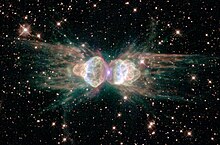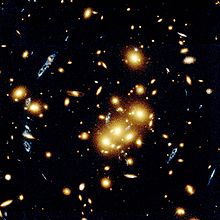Astronomy college course/Astronomy (wikipedia)/questions
Appearance
Introduction to Wikipedia astronomy article
- What is the difference between cosmology and astronomy?
- Name two practical reasons ancient civilizations found astronomy useful.
- Of all the fields of science, which seems to be the most connected with astronomy?
- According to Wikipedia, modern astronomy has now split into what two major branches.
- What is the difference between astronomy and astrology?
Lexicology: No questions
[edit | edit source]History
[edit | edit source]All figures will be given on the test with the same captions.

- What two terms refer to cosmological models in which the Earth is considered the center of the universe.
- Where did mathematical and scientific astronomy first emerge among the ancients?
- What is the Saros cycle?
- In the 3rd century BC, Aristarchus of Samos estimated
- The most of the constellations in _______ hemisphere derive from _______ astronomy
- It wasn't until ____ years after the Greek antikythera device that artifacts of similar complexity again appeared in Europe (answer to within 500 years)
- Who discovered the Andromeda galaxy and when (to within 300 years, and name the nationality only)
- What is the larges galaxy in our local group of galaxies
- In 1066 AD a supernovae was discovered by astronomers in _____ and _____
- (Figure: Hand drawn sketches) Who drew these sketches? What object is it? What conclusion was drawn from them?
- In what century was it proved that the Sun is a member of the Milky Way, which is only one of an enormous number of such galaxies.
- What is the name of the first new planet found (after those known by the ancients using the naked eye)
- In what century was parallax first used to measure the distance to a Star (other than our Sun)
- Joseph von Fraunhofer discovered about 600 bands in the _______ of the Sun in 1814–15, which, in 1859, Gustav Kirchhoff ascribed to the presence of different _____________.
Observational astronomy
[edit | edit source]- Most of the radio emission from space that is observed from Earth is produced when ____ orbit around _________.
- An important radio wave is produced by ____________, the wavelength is 21 cm and it is emitted by what element.
- Name two objects that are important emitters of radio waves from space.
- Infrared astronomy deals with radiation with wavelengths _______ than red light. (longer, shorter, or the same as)
- Infrared observatories have to be located in high, ______ places or in space.
- The infrared spectrum is useful for studying objects that are too ______to radiate visible light, such as _______.
- What is it about longer infrared wavelengths that allows observation of young stars located in galactic cores and molecular clouds?
- Historically, ________ astronomy, also called visible light astronomy, is the oldest form of astronomy.
- Ultraviolet astronomy is generally used to refer to observations at wavelengths which are ________ than blue light. (longer/shorter)
- Ultraviolet astronomy is best suited to the study of thermal radiation from hot or cold stars?
- Name two objects that are not stars that are observed using ultraviolet light?
- An important X-ray source is the ________ remnant.
- X-rays were first observed and documented in 1895 by a German scientist who made an infamous X-ray photograph of wife's _____ with a _________.
- Röntgen called this new radiation "X" because ____________. (Finish sentence)
- Gamma ray astronomy is the study of astronomical objects at the ___________ of the electromagnetic spectrum.
- Most gamma-ray emitting sources are which only produce gamma radiation for ____________ (finish sentance).
- Other gamma-ray emitters include _________ _____________ candidates.
- Where are neutrino detectors located?
- Neutrinos observed on Earth originate overwhelmingly from ________ but 24 unexpected neutrinos were also detected from __________1987A.
- Why is it routine for observing stations hundreds of miles apart to detect the same cosmic ray?
- During the 1990s, the astrometric technique of measuring stellar wobble lead to the discovery of _________.(Finish sentence)
Theoretical astronomy
[edit | edit source]- A theoretical model of Gravitational collapse can be developed using equations from the theory of General relativity. Experimental observation of of Xray radiation could test these calculations and help us understand whether _______ _______ exist at the center of Andromeda galaxy.
- Dark ______ and dark _______ are the current leading topics in astronomy,as their discovery and controversy originated during the study of the galaxies.
Specific subfields
[edit | edit source]


- Solar Astronomy: It takes about ________ __________ for light from the Sun to reach Earth (word bank: 8, 80, seconds, minutes, days, years)
- Is the Sun classified as a variable star?
- The Sun exhibits is an _____ ____ fluctuation in sunspot numbers. (Word bank: 3, 11, 333, day, month, year)
- Sunspots are regions of _______-than- average temperatures
- The Sun has steadily _______ in luminosity over the course of its life, by 40% since it first became a main-sequence star. (increase or decrease?)
- The visible outer surface of the Sun is called the photosphere. Above this layer is a thin region known as the chromosphere, which is surrounded by a transition region between the sun and the corona, which can be thought as the highest and part of the Sun's atmosphere. Is this upper atmosphere hotter or colder than the region below?
- At the center of the Sun is the core region, a volume of sufficient _________ and _________for nuclear fusion to occur.
- A _____ _______ of particles constantly streams outward from the Sun
- Planetary science: (Figure: Black spot upper center) What is the black spot in the upper center? Where is it?
- The Solar System is subdivided into the inner planets, the asteroid belt, and the outer planets. Name two outer planets.
- The inner terrestrial planets consist of Mercury, Venus, Earth, and _______.
- The outer planets are also called _______ planets.
- Beyond Neptune lies ____________.
- The planets were formed in the protoplanetary disk that surrounded the early Sun. (Proto means "first" and the disk is a disk of gas and dust). Name one process that brought this gas and dust together to become the protoplanets.
- What evidence do we have that there was an early period of intense bombardment?
- (Figure: The ant nebula). This is a _______ star.
- Star formation occurs in dense regions of dust and gas, known as giant _______ _______.
- Almost all elements heavier than ________ and _______ were created inside the cores of stars.
- The characteristics of the resulting star depend primarily upon how much ______it had at the beginning.
- The final fate of the star depends on its mass, with stars of mass greater than about eight times the Sun becoming _____________.
- Our solar system] (i.e. Sun) orbits within the __________ __________
- In the center of the Milky Way is tis believed to be a ________ __________ at the center.
- Kinematic studies of matter in the Milky Way and other galaxies refers to how fast the stars are moving. These studies demonstrated that there is more ___________ than can be accounted for by visible matter.
- Extragalactic astronomy: (Figure: blue loop-shaped objects) The multitude of blue loop-shaped objects are _______ (finish the sentance)
- An active galaxy is emitting a significant amount of its energy from a source usually thought to be a super-massive black hole that is emitting radiation that gets it energy from _________(finish the sentence).
- Cosmology:could be considered the study of the universe _________(finish the sentence).
Interdisciplinary studies
[edit | edit source]- The study of whether life exists elsewhere in the universe is called ________-astronomy.
- The study of how ancient cultures related to the nighttime sky is called ________-astronomy.
- Forensic Astronomy was used to date a painting by what artist? What about the painting helped date it? (click the link).
Amateur astronomy
[edit | edit source]- The most well known field where amateur astronomers make significant contributions is the search for comets. Under the magnification used by the professional telescopes, the sky is just too 'big' for the big telescopes to track every night, especially since a professional telescope might spend hours collecting light from one source. But in the 1930s, Karl Janksy made pioneering contributions in field of ______ astronomy.
Unsolved problems in astronomy
[edit | edit source]- Name two unsolved problems in astronomy.
